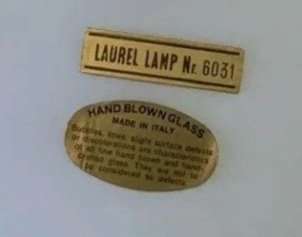How to Identify a Laurel Lamp
Laurel Lamp Company Pieces
The Laurel Lamp Manufacturing Company produced lighting fixtures and lamps from 1946 to 1981 creating well over 1,000 unique lighting designs during that time in numerous styles, finishes, and variations.
Laurel’s vast inventory of lighting included table lamps, floor lamps, desk lamps, pole lamps, piano and organ lamps, stick lamps, torchieres, torchettes, accent “ac’-cent” lamps, arc lamps, swag lamps, mini lamps, task lamps, slide-lights, high-intensity lamps, wall lamps, sconces, and more along with other home furnishings.
Laurel produced sculptural lighting pieces in wood, metal, glass, cork, acrylic, lucite, and other novel materials sourced from around the world.
The Laurel Lamp Company also manufactured different types of tables (both with and without lighting components) and various types of home furnishing accessories including ashtrays, sculptures, and artwork.
Below you find information on how to help identify a Laurel Lamp.
Markings and Labels
Laurel pieces were originally manufactured in-house at Laurel’s Newark headquarters and were marked with the company name and/or logo in various ways following production. Throughout the decades the markings and labels affixed to Laurel pieces differs slightly and can provide insight into the date they were manufactured.
While Laurel began producing lamps in the mid 1940s, the earliest Laurel lamp our nonprofit foundation’s curator has been able to authenticate is from the early 1950s.
Some Laurel pieces of this era were marked on the underside of the lamp base with an etched Laurel Lamp Company maker’s mark usually visible as “LLCo” in a few different styles including cursive and print. Some Laurel Lamps produced in the 1960s also bear this same “LLCo” logo etched in the metal.
Below are a few examples of the various maker marks seen on Laurel’s pieces from the 1950s and 1960s.
The blue UL labels contained an issue number from Underwriters Laboratory certifying that the design for the electrical components of the lamp met all necessary safety criteria. The UL issue numbers were sequential and originally consisted of a 5 digit number.
Below the issue number on the UL sticker, it reads “LAUREL LAMP MFG. CO. INC., NEWARK 5, N.J.
At some point in the mid 1960s the UL label switched to listing the zip code of Laurel’s Newark factory reading ““LAUREL LAMP MFG. CO. INC., NEWARK,, N.J 07105”.
A Laurel Lamp Company UL label from the mid 1960s showing inspection from Underwriters Laboratories Inc.
Beginning in the 1950s, Laurel Lamps were originally marked with a blue label from Underwriters Laboratory. Underwriters Laboratories (UL) is a global safety company that has certified the construction of electrical devices in the United States since the early 1900s. The UL sticker was typically found affixed to the original lamp socket or placed somewhere on the underside of the lamp shade depending on the model and style.
The first examples of Laurel Lamps being marked with any type of sticker are from sometime in the 1950s. Some Laurel Lamps were marked on their original lamp sockets with a red caution label which read “LAUREL LAMP MFG. CO. INC., NEWARK 5, N.J.” typically indicating the maximum watt bulb safely recommended for the lamp (pictured below). Others early Laurel pieces were marked with a different red sticker marked “Use GE 100 A/X 100 WATT BULB only” and read “LAUREL LAMP MFG CO INC, NEWARK 5, NJ”.
A UL label from a Laurel Lamp manufactured in the late 1970s as evidence by the Issue Number.
Example of an original oval or “mushroom shaped” glass globe hand blown in Italy (left) and imported to the United States marked with two separate stickers. The top sticker indicates the style number of the glass globe while the bottom sticker shows where it was originally produced.
A close up of the sticker (right) reads “Originally all of these hand blown pieces were marked with a sticker reading: “Handblown Glass Made In Italy, Bubbles, lines, slight surface defects or discolorations are characteristics of all fine hand blown and hand-crafted glass. They are not to be considered defects.”
The bottom of three different Laurel lamps etched with a “LLCo” maker’s mark on the underside of the lamp base from the 1950s and early 1960s. Please note the numbers seen correlate with the lamp model assigned to each piece rather than the year they were manufactured.
A safety sticker found a Laurel Lamp Company piece marked “LAUREL LAMP MFG CO INC, NEWARK 5, NJ”.
A Laurel Lamp Company piece marked with a red label indicating the correct wattage with the legal name of the company printed below.
Imported Glass
While the Laurel Lamp Company manufactured the majority of its lamp components in its Newark, New Jersey factory, Laurel imported glass shades and other lamp components from high-end manufacturers around the world including from glass artists in Italy, Sweden, and Finland.
The glass globes on Laurel pieces were originally marked with stickers denoting where the glass was originally produced.
Laurel’s iconic “mushroom lamps” had metal bases produced at the Laurel factory but the glass globes were made of imported hand blown glass from Italy. Originally all of these hand blown pieces were marked with a sticker reading: “Handblown Glass Made In Italy, Bubbles, lines, slight surface defects or discolorations are characteristics of all fine hand blown and hand-crafted glass. They are not to be considered defects.”









